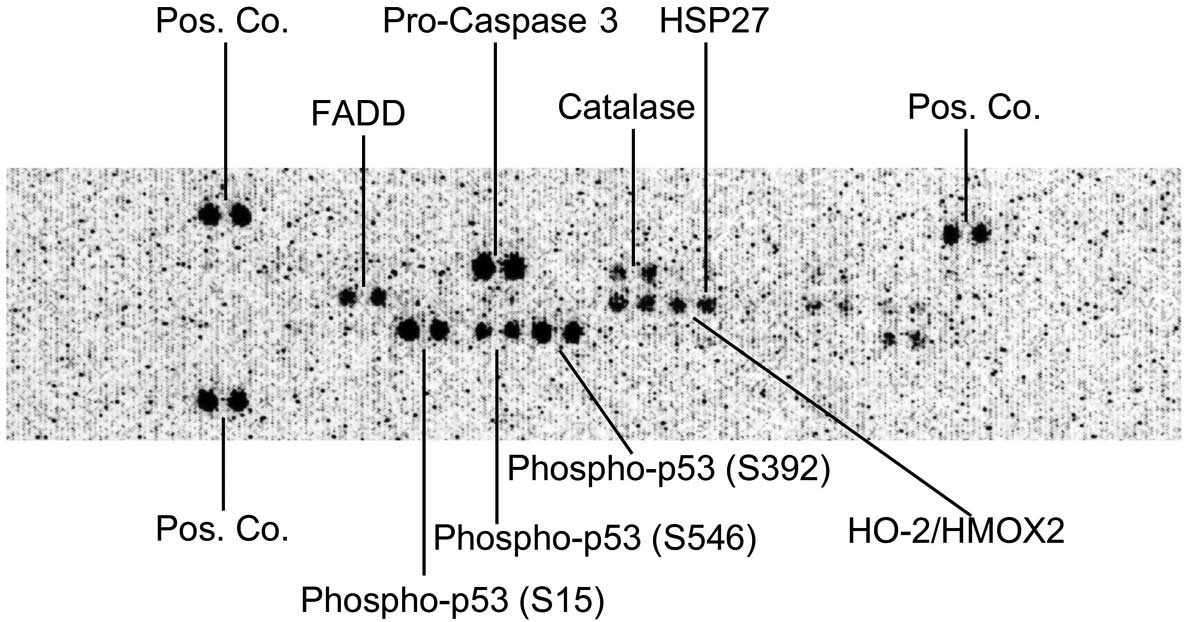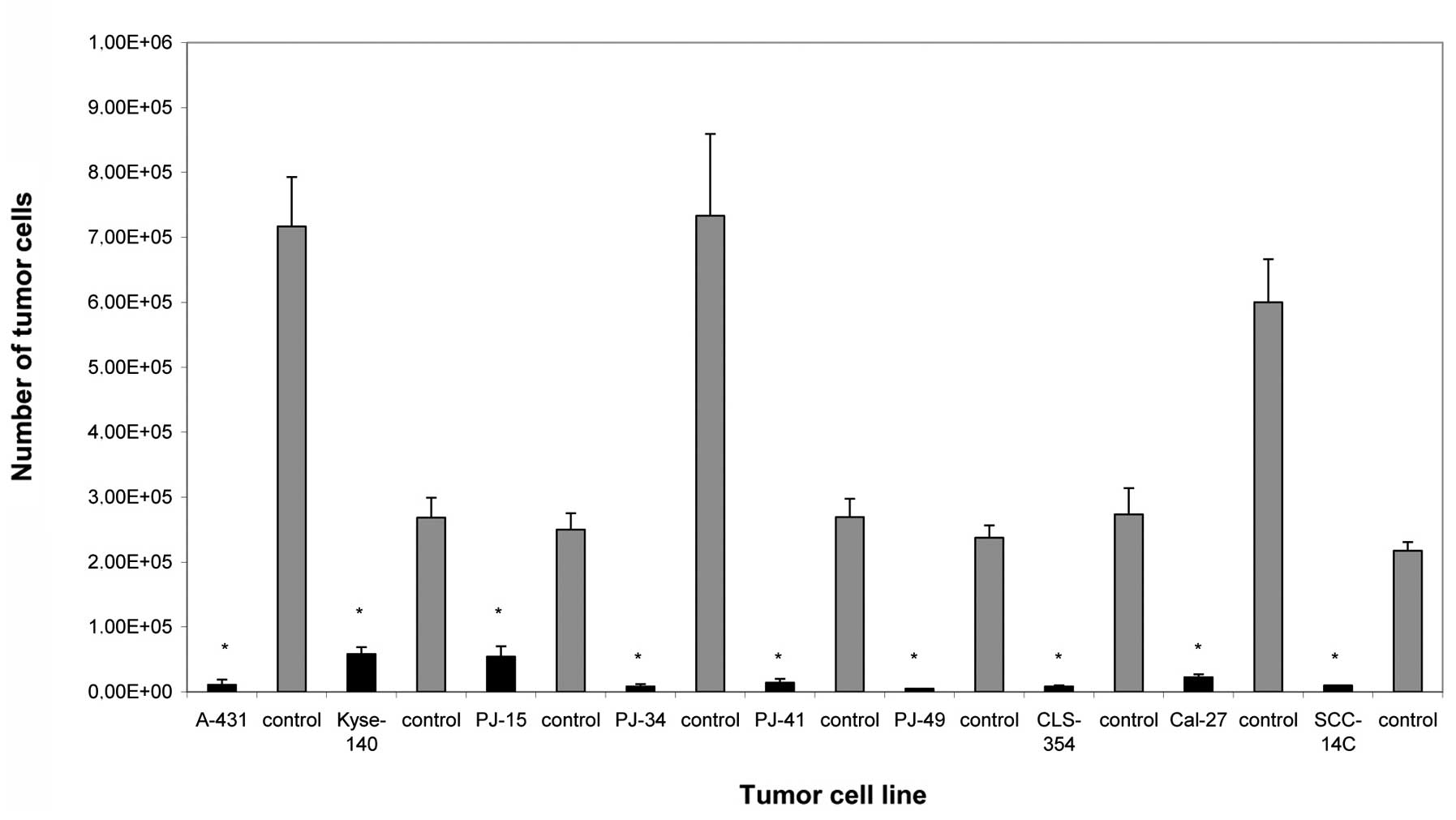Introduction
Cancer of the head and neck is one of the most
common types of cancer worldwide. Each year more than 600,000 new
diagnoses are made worldwide, with the most common sites being the
oral cavity, the larynx and the pharynx (1). Although outcomes can differ between
tumors of the same stage, the prognosis of patients suffering from
head and neck cancer is mainly dependent on the tumor stage,
particularly the lymph node status. Besides tobacco and alcohol
abuse, an oropharyngeal infection with high-risk human
papillomavirus, such as HPV 16 and HPV 18, may lead to the
development of a squamous cell carcinoma, particularly of organs of
the oral cavity such as the tonsils, tongue and palate (2). Based on the fact that primarily
younger patients suffer from HPV-induced cancer of the head and
neck, it seems as if high-risk HPV presents an additional risk
factor.
Although surgical techniques and conservative drug
therapy strategies have become more efficient in the last decades,
prognosis of this type of cancer remains poor. As such, finding new
efficient treatment strategies with a long-term beneficial effect
is a great challenge. Thus, new antineoplastic drugs must be found
and evaluated in vitro and in vivo (3). Fine-mapping of the cell-division
cycle, particularly the identification of mitotic kinase signaling
pathways, offers new opportunities for cancer-drug development.
Polo-like kinase 1 (PLK1) is a major mitotic regulator
overexpressed in numerous solid and hematopoietic tumors (4). Moreover, PLK1 plays a key role in the
cell cycle at the G2/M transition and in mitosis (5) and is a negative prognostic marker in
specific human cancer types (6–8). In
this study, we show the first results obtained with BI2536, a
potent small-molecule inhibitor of mammalian PLK1, that inhibits
PLK1 activity at low nanomolar concentrations. The aim of the
present study was to systematically investigate the growth
inhibitory and apoptotic activity of BI2536 as a single agent in
nine squamous carcinoma cell lines.
Materials and methods
Materials
Nine different squamous carcinoma cell lines, mainly
of head and neck origin, were tested in this study. A-431 cells
were obtained from American Type Culture Collection (ATCC;
Manassas, VA, USA). PE/CA-PJ 15, PE/CA-PJ 41, PE/CA-PJ 49 and
PE/CA-PJ 34 cells were obtained from ECACC (European Collection of
Cell Cultures), and Cal-27 and Kyse-140 cells from DSMZ GmbH,
Braunschweig, Germany. CLS-354 and UM-SCC-14C cells were obtained
from Cell Lines Service (CLS, Eppelheim, Germany). The fibroblast
cell line was a gift from the Department of Dermatology, University
Hospital, Frankfurt/Main, Germany.
Methods
BI2536 was provided by Boehringer Ingelheim GmbH,
Austria. Squamous carcinoma cell lines were cultivated according to
the instructions of the suppliers with antibiotics at 37°C in the
cell type-specific medium Quantum 263 with L-glutamine (PAA
Laboratories GmbH, Pasching, Austria). Cells were seeded in
96-multiwell plates (1×105 cells/well). Following
incubation for 24 h, the cells were treated with BI2536 for 24, 48
and 76 h, respectively. In the experiments described in this study,
BI2536 was used in each cell line at a fixed, cell line-specific
concentration that had produced maximum growth inhibition in
previous systematic investigations in our laboratory. The
concentration for the cell lines investigated was 2.5 nmol/l for
BI2536, which demonstrated maximal growth inhibition in our
previous dose escalation studies (unpublished data). The number of
cells was determined by counting cells in a Rosenthal chamber at
24, 48 and 72 h subsequent to treatment. Apoptosis was detected by
microscopic cytohistology as well as by a Human Apoptosis Array Kit
(R&D Systems, Abingdon, UK) as previously described by other
groups (9,10) (Fig.
2).
Statistical analysis
Each experiment was carried out in triplicate. For
statistical analysis, a Wilcoxon test for matched pairs (dependent
samples) was performed using SPSS 19.0 software for Windows.
Differences of p<0.05 were considered statistically
significant.
Results
Nine different squamous carcinoma cell lines, mainly
of head and neck origin, were tested in this study. Following 24 h
incubation, the cells were treated with BI2536 for 24, 48 and 76 h,
respectively. Compared with the untreated control groups, the PLK1
inhibitor BI2536 had a highly significant antiproliferative and
apoptotic effect in all nine tumor cell lines (p< 0.009)
(Fig. 1). Apoptosis was detected by
microscopic cytohistology as well as by a Human Apoptosis Array Kit
(R&D Systems). Additionally, pro-caspase 3 was detected as a
typical apoptotic marker (Fig. 2).
BI2536 is therefore a potent small-molecule inhibitor of mammalian
PLK1 that inhibits PLK1 activity at low nanomolar concentrations
leading to an apoptotic effect in nine squamous carcinoma cell
lines.
Discussion
Previously, a growing body of biochemical
investigations contributed to the improved characterization of
biological tumor behaviour, thereby improving treatment strategies.
PLK1 is a marker of cell proliferation that shows an elevated
expression in a number of solid tumors (11,12).
Previous studies have been able to demonstrate that the level of
PLK1 correlates with metastasis in cervical lymph nodes (13). Moreover, there was a significantly
higher occurrence of PLK expression in metastatic HNSCC than in
non-metastatic tumors. This observation suggests that the
determination of PLK expression in primary tumors of the head and
neck indicates the metastasizing potential of a tumor (13). Patients could be subdivided by PLK
expression into those with better or worse prognosis, suggesting
PLK levels as a discriminatory marker within conventional tumor
stages (13). Despite the
development of multimodal treatment strategies in head and neck
cancer disease, the overall 5-year survival rate in stages UICC III
and IV remains poor (14). As such,
finding new efficient treatment strategies with long-term
beneficial effects is necessary. Thus, new antineoplastic drugs
that show less toxicity but a high antineoplastic potency should be
evaluated in vitro and in vivo (3,15).
The dihydropteridinone derivate BI2536 is a potent
small-molecule inhibitor of mammalian PLK1 that inhibits PLK1
activity at low nanomolar concentrations. BI2536 induces G2/M
arrest and the formation of abnormal mitotic figures, such as
monopolar spindles. Although there are already clinical phase I and
II trials conducted in which BI2536 is administered in different
tumor entities there remains a need for further in vitro
studies focusing on the pharmacological profile of BI2536 (16). In the present study, we
systematically evaluated the effect of BI2536 in nine different
squamous cell carcinoma cell lines for the first time. Compared
with the untreated control groups, BI2536 had a highly significant
antiproliferative and apoptotic effect in all nine tumor cell
lines. Taken together, based on our promising results, BI2536 may
be of great interest in future treatment regimes used for head and
neck cancer.
In conclusion, PLK1 is a major mitotic regulator
overexpressed in various solid and hematopoietic tumors. In the
present study, BI2536, a potent small-molecule inhibitor of
mammalian PLK1 demonstrated, when applied as a single agent, a
strong inhibition of cell proliferation accompanied by enhanced
apoptosis in nine different squamous carcinoma cell lines.
Introducing drugs that block PLK1 to head and neck cancer therapy
may improve adjuvant or non-surgical conservative treatment of this
tumor identity. More studies are required to prove whether there is
an enhancing antitumoral effect of BI2536 in combination with
docetaxel or cisplatin that are, among other drugs such as
paclitaxel and 5-fluorouracil, commonly used in the modern
treatment of head and neck cancer. Our results emphasize that
targeting the PLK signaling pathway is a potentially noteworthy
therapeutic target for the modern treatment of head and neck cancer
disease.
Acknowledgements
We thank Erika Weith for her excellent technical
support. We also thank Boehringer Ingelheim for their donation of
BI2536.
References
|
1
|
Mehanna H, Paleri V, West CM and Nutting
C: Head and neck cancer - Part 1: epidemiology, presentation, and
prevention. BMJ. 341:c46842010. View Article : Google Scholar : PubMed/NCBI
|
|
2
|
Maden C, Beckmann AM, Thomas DB, McKnight
B, Sherman KJ, Ashley RL, et al: Human papillomaviruses, herpes
simplex viruses, and the risk of oral cancer in men. Am J
Epidemiol. 135:1093–1102. 1992.PubMed/NCBI
|
|
3
|
Wagenblast J, Hambek M, Baghi M, Gstottner
W, Strebhardt K, Ackermann H, et al: Antiproliferative activity of
bortezomib alone and in combination with cisplatin or docetaxel in
head and neck squamous cell carcinoma cell lines. J Cancer Res Clin
Oncol. 134:323–330. 2008. View Article : Google Scholar : PubMed/NCBI
|
|
4
|
Renner AG, Dos Santos C, Recher C, Bailly
C, Creancier L, Kruczynski A, et al: Polo-like kinase 1 is
overexpressed in acute myeloid leukemia and its inhibition
preferentially targets the proliferation of leukemic cells. Blood.
114:659–662. 2009. View Article : Google Scholar : PubMed/NCBI
|
|
5
|
Van de Weerdt BC and Medema RH: Polo-like
kinases: a team in control of the division. Cell Cycle. 5:853–864.
2006.PubMed/NCBI
|
|
6
|
Steegmaier M, Hoffmann M, Baum A, Lenart
P, Petronczki M, Krssak M, et al: BI 2536, a potent and selective
inhibitor of polo-like kinase 1, inhibits tumor growth in vivo.
Curr Biol. 17:316–322. 2007. View Article : Google Scholar : PubMed/NCBI
|
|
7
|
Takai N, Hamanaka R, Yoshimatsu J and
Miyakawa I: Polo-like kinases (Plks) and cancer. Oncogene.
24:287–291. 2005. View Article : Google Scholar : PubMed/NCBI
|
|
8
|
Strebhardt K and Ullrich A: Targeting
polo-like kinase 1 for cancer therapy. Nat Rev Cancer. 6:321–330.
2006. View
Article : Google Scholar : PubMed/NCBI
|
|
9
|
Datta D, Banerjee P, Gasser M,
Waaga-Gasser AM and Pal S: CXCR3-B can mediate growth-inhibitory
signals in human renal cancer cells by down-regulating the
expression of heme oxygenase-1. J Biol Chem. 285:36842–36848. 2010.
View Article : Google Scholar : PubMed/NCBI
|
|
10
|
Ray RB, Raychoudhuri A, Steele R and
Nerurkar P: Bitter melon (Momordica charantia) extract
inhibits breast cancer cell proliferation by modulating cell cycle
regulatory genes and promotes apoptosis. Cancer Res. 70:1925–1931.
2010.PubMed/NCBI
|
|
11
|
Holtrich U, Wolf G, Brauninger A, Karn T,
Bohme B, Rubsamen-Waigmann H, et al: Induction and down-regulation
of PLK, a human serine/threonine kinase expressed in proliferating
cells and tumors. Proc Natl Acad Sci USA. 91:1736–1740. 1994.
View Article : Google Scholar : PubMed/NCBI
|
|
12
|
Wolf G, Elez R, Doermer A, Holtrich U,
Ackermann H, Stutte HJ, et al: Prognostic significance of polo-like
kinase (PLK) expression in non-small cell lung cancer. Oncogene.
14:543–549. 1997. View Article : Google Scholar : PubMed/NCBI
|
|
13
|
Knecht R, Elez R, Oechler M, Solbach C,
von Ilberg C and Strebhardt K: Prognostic significance of polo-like
kinase (PLK) expression in squamous cell carcinomas of the head and
neck. Cancer Res. 59:2794–2797. 1999.PubMed/NCBI
|
|
14
|
Jemal A, Murray T, Ward E, Samuels A,
Tiwari RC, Ghafoor A, et al: Cancer statistics. CA Cancer J Clin.
55:10–30. 2005.
|
|
15
|
Wagenblast J, Baghi M, Arnoldner C, Bisdas
S, Gstottner W, Ackermann H, et al: Cetuximab enhances the efficacy
of bortezomib in squamous cell carcinoma cell lines. J Cancer Res
Clin Oncol. 135:387–393. 2009. View Article : Google Scholar : PubMed/NCBI
|
|
16
|
Schoffski P, Blay JY, De Greve J, Brain E,
Machiels JP, Soria JC, et al: Multicentric parallel phase II trial
of the polo-like kinase 1 inhibitor BI 2536 in patients with
advanced head and neck cancer, breast cancer, ovarian cancer, soft
tissue sarcoma and melanoma. The first protocol of the European
Organization for Research and Treatment of Cancer (EORTC) Network
Of Core Institutes (NOCI). Eur J Cancer. 46:2206–2215. 2010.
|
















